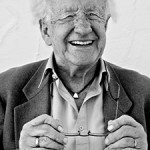Peace Studies: Ten Basic Points
By Johan Galtung
Foreign Policy Studies, University of Malmö, Sweden
Thanks for wanting a summary of key points in “Galtung Peace Studies”. I was just honored with a “Lifetime Award” by world sociology, 60+ years; in short, time for summary with an author’s caveat: no substitute for reading books.
[1] 1951: Peace studies=peace theory+peace practice; applied science, with an explicit value–peace–with practice-indicative theories and theory-testing practice; like health studies, unlike social sciences. Model: peace to violence as health to illness; Diagnosis-Prognosis-Therapy produced health by weakening pathogens-strengthening sanogens; try the same for peace by weakening bellogens-strengthening paxogens. Mantra: through interdisciplinary, international, interlevel research.
[2] Like in illness violence=suffering of body-mind-spirit, also of the bereaved; unlike in illness, an intended act of commission, a perpetrator-victim relation, a crime, epitomized by aggressive war. Body wounds may be healed but stigma, shame, humiliation, hopelessness, hatred, fear, revenge may settle in mind and spirit as trauma. To judicial approaches, sentence and punishment–against theft of cherished property, violence to the body and sexual violence – add victim – and context-oriented approaches like having less property, more company, no provocation and context-oriented approaches as for instance un-uniformed citizens as vigilantes in public space, etc.
But the antidote to violence is peace: a structure of positive interaction, a culture of nonviolence, focus on the positive in the yin/yang of others and on change from violent to peaceful relations, rather than on party attributes; relations carry more causal weight and are irreducible to attributes: see relation logic-buddhism-daoism.
[3] Peace was liberated from the state focus to cover five levels:
peace with nature, environmental peace;
micro level: within, and among persons in families, at school, work;
meso level: among groups, generations-genders-races-classes-nations;
macro level: among states, nations and nations-and-states;
mega level: among regions, civilizations; within the world.
[4] 1958: Peace divided into negative and positive peace – the absence of violence; and the presence of cooperation and harmony. Synonyms: security; and convivencia in Spanish, kyosei in Japanese (English?). Thesis: a context of positive peace contributes to negative peace like a context of body-mind-spirit-social balance-wellness reduces illness.
[5] 1965: Violence divided into direct and structural violence, the unintended acts of omission that maintain structures of inequality, overload, isolation, underload; economically, militarily, politically, culturally; generally killing-wounding much more than direct violence; adding to this cultural violence legitimizing direct and structural.
[6] Peace Formula: paxogens/bellogens (health: sanogens/pathogens); positive peace/absence of negative peace. Key paxogens are Equity (cooperation for mutual and equal benefit) and Empathy (for harmony, suffering the suffering and enjoying the joy of others); key bellogens are unreconciled Trauma and unsolved Conflict = incompatible goals:
Equity X Empathy
Peace = ——————–
Trauma X Conflict
This implies four major peace tasks: Building Equity, Educating for Harmony, Reconciling Trauma and Solving Conflict; all relational, all maxi-3C, constructive-concrete-creative, avoiding moralism-criticism.
It is based on a holistic view of systems with contradictions, aiming at their transcendence through mediation based on dialogue and the mutual search for a new reality. Peace theory is based on Negotiation, Rule of Law, Human Rights, Democracy, and assumes that the sum of domestic peace(s) is global peace, and that compromise is sufficient; world law, global rights, UN democracy and new realities may be needed.
In short, a peace culture with five components: dialogue-equity-empathy-conciliation-solution. The negation is a violence culture; as an illness culture negates a health culture of hygiene, avoiding dangers, good nutrition, exercise and solving dilemmas and conflicts.
[7] Building Equity. Equalizing the side-effects, externalities of interaction; peace business being an effort.
[8] Education for Harmony. Awareness of own and other world views and goals; peace education being an effort.
[9] Reconciling Trauma. Clearing the past, wishing violence undone and cooperating for a better future; peace journalism being an effort.
[10] Solving Conflict. Creating new realities by making legitimate incompatible goals compatible; peace journalism being an effort.
Let us try it out on a concrete case: the relation of the Jewish nation – with the immense suffering – to the rest of the world:
Peace is spelled out as reducing violent behavior-attitude and securing an Israel with Jewish attributes (Jewish state = only Jews?). The diagnosis is based on rank discordance with a minority high on economic-cultural and majority on political-military power, a recipe for disaster; on a frequent prejudice; and on “facts on the ground” (settlement=colonialism). The prognosis is based on similar cases.
Therapy removes causes of violence, building peace on 1-2-6-20, possibly with Israeli cantons on the West bank and Palestinian in Northwest Israel (whence much of the Naqba originated). MEC, Middle-East Community, would include Israel and the five Arab neighbors, modeled on the European Community of 1 January 1958, and OSCWA would include their neighbors and neighbors’ neighbors, modeled on OSCE-Organization for Security and Cooperation in Europe.
Peace studies add forecasting and visions of therapy to analysis, and practice to theory; for negative and positive peace.
Notes
(*) MEC – Middle East Community.
(**) OSCWA-Organization for Security and Cooperation in West Asia–does not exist, but is needed.
Originally published here.

